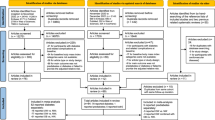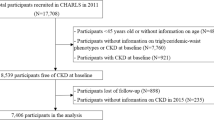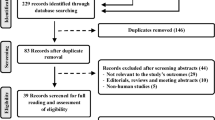Abstract
We performed a meta-analysis to assess the association of body mass index (BMI) and metabolic status with the risk of incident hypertension. Relevant studies were identified by searching comprehensive search via PubMed and Scopus search engines up to May 2018 and were analyzed using a random-effects model. Eight prospective studies were included in the analyses with metabolically healthy normal weight (MHNW) as the reference group. Pooled relative risks (RRs) and their 95% confidence intervals (CI) were calculated using random-effects or fixed-effect models when appropriate. Subgroup analysis was applied to define possible sources of heterogeneity. Overall, among 79090 participants, the risk of hypertension in metabolically unhealthy obese (MUHO) and metabolically healthy obese phenotypes (MHO) increased compared with the reference group (pooled effect size = 1.95, 95%CI: 1.87–2.04, P < 0.001 vs pooled effect size: 1.54, 95%CI: 1.48–1.61, P < 0.001, respectively). Also, a significant positive association between metabolically unhealthy normal weight (MUHNW) phenotype and the risk of hypertension was observed (pooled effect size = 1.48, 95%CI: 1.41–1.55, P < 0.001). Metabolically unhealthy overweight (MUHOW) and metabolically healthy overweight (MHOW) phenotypes had greater risk of hypertension compared with the MHNW phenotype (pooled effect size = 1.50, 95%CI: 1.13–1.71, P < 0.001 and pooled effect size = 1.18, 95%CI: 1.11–1.27, P < 0.001). This meta-analysis revealed that individuals with metabolic abnormality had a higher risk for hypertension and also suggests that MHOW/ MHO are not a benign condition. We are refuting the notion that overweight and obesity without metabolic abnormalities are benign conditions in all population.
This is a preview of subscription content, access via your institution
Access options
Subscribe to this journal
Receive 12 digital issues and online access to articles
$119.00 per year
only $9.92 per issue
Buy this article
- Purchase on Springer Link
- Instant access to full article PDF
Prices may be subject to local taxes which are calculated during checkout







Similar content being viewed by others
References
Michael D. Jensen, Donna H. Ryan, Karen A. Donato, Caroline M. Apovian, Jamy D. Ard, Anthony G. Comuzzie et al. Executive summary: Guidelines (2013) for the management of overweight and obesity in adults: a report of the American College of Cardiology/American Heart Association Task Force on Practice Guidelines and the Obesity Society published by the Obesity Society and American College of Cardiology/American Heart Association Task Force on Practice Guidelines. Based on a systematic review from the The Obesity Expert Panel, 2013. Obesity. 2014;22(Suppl 2): S5–39.
Phillips CM, Dillon C, Harrington JM, McCarthy VJ, Kearney PM, Fitzgerald AP, et al. Defining metabolically healthy obesity: role of dietary and lifestyle factors. PLoS ONE 2013;8:e76188.
Pi‐Sunyer FX. The obesity epidemic: pathophysiology and consequences of obesity. Obesity. 2002;10(S12):97S–104S.
Silveira EA, Vieira LL, Souza JD. [High prevalence of abdominal obesity among the elderly and its association with diabetes, hypertension and respiratory diseases]. Cien Saude Colet. 2018;23:903–12.
Chan JM, Rimm EB, Colditz GA, Stampfer MJ, Willett WC. Obesity, fat distribution, and weight gain as risk factors for clinical diabetes in men. Diabetes Care. 1994;17:961–9.
Guh DP, Zhang W, Bansback N, Amarsi Z, Birmingham CL, Anis AH. The incidence of co-morbidities related to obesity and overweight: a systematic review and meta-analysis. BMC Public Health. 2009;9:88.
Collaboration PS. Body-mass index and cause-specific mortality in 900 000 adults: collaborative analyses of 57 prospective studies. Lancet. 2009;373:1083–96.
Sims EA. Are there Pers who are obese, but Metab Healthy? Metab Clin Exp. 2001;50:1499–504.
Seo MH, Rhee E-J. Metabolic and cardiovascular implications of a metabolically healthy obesity phenotype. Endocrinol Metab. 2014;29:427–34.
Boonchaya-Anant P, Apovian CM. Metabolically healthy obesity—does it exist? Curr Atheroscler Rep. 2014;16:441.
Bluher M. The distinction of metabolically ‘healthy’ from “unhealthy” obese individuals. Curr Opin Lipidol. 2010;21:38–43.
Karelis AD. To be obese—does it matter if you are metabolically healthy? Nat Rev Endocrinol. 2011;7:699–700.
Calori G, Lattuada G, Piemonti L, Garancini MP, Ragogna F, Villa M, et al. Prevalence, metabolic features, and prognosis of metabolically healthy obese Italian individuals: the Cremona Study. Diabetes Care. 2011;34:210–5.
Kramer CK, Zinman B, Retnakaran R. Are metabolically healthy overweight and obesity benign conditions? A systematic review and meta-analysis. Ann Intern Med. 2013;159:758–69.
Ruizhi Z, Zhou D, Zhu Y. The long-term prognosis of cardiovascular disease and all-cause mortality for metabolically healthy obesity: a systematic review and meta-analysis. J Epidemiol Commun Health. 2016;70:1024–31.
Lee SH, Han K, Yang HK, Kim HS, Cho JH, Kwon HS, et al. A novel criterion for identifying metabolically obese but normal weight individuals using the product of triglycerides and glucose. Nutr Diabetes. 2015;5:e149.
Aung K, Lorenzo C, Hinojosa MA, Haffner SM. Risk of developing diabetes and cardiovascular disease in metabolically unhealthy normal-weight and metabolically healthy obese individuals. J Clin Endocrinol Metab. 2014;99:462–8.
Karelis AD. Metabolically healthy but obese individuals. Lancet. 2008;372:1281–3.
Wildman RP, Muntner P, Reynolds K, McGinn AP, Rajpathak S, Wylie-Rosett J, et al. The obese without cardiometabolic risk factor clustering and the normal weight with cardiometabolic risk factor clustering: prevalence and correlates of 2 phenotypes among the US population (NHANES 1999–2004). Arch Intern Med. 2008;168:1617–24.
Huang K, Song YT, He YH, Feng XL. Health system strengthening and hypertension management in China. Glob Health Res Policy. 2016;1:13.
Stroup DF, Berlin JA, Morton SC, Olkin I, Williamson GD, Rennie D, et al. Meta-analysis of observational studies in epidemiology: a proposal for reporting. Meta-analysis Of Observational Studies in Epidemiology (MOOSE) group. JAMA. 2000;283:2008–12.
Wells G, Shea B, O’Connell D (editors). The Newcastle–Ottawa Scale (NOS) for Assessing the Quality of non-randomised studies in meta-analysis. Proceedings or the Third Symposium on Systematic Reviews beyond the Basics; 2000.
Higgins J, Thompson SG. Quantifying heterogeneity in a meta‐analysis. Stat Med. 2002;21:1539–58.
DerSimonian R, Laird N. Meta-analysis in clinical trials. Control Clin Trials. 1986;7:177–88.
Mantel N, Haenszel W. Statistical aspects of the analysis of data from retrospective studies. J Natl Cancer Inst. 1959;22:719–48.
Egger M, Smith GD, Schneider M, Minder C. Bias in meta-analysis detected by a simple, graphical test. BMJ. 1997;315:629–34.
Jae SY, Babu AS, Yoon ES, Kurl S, Laukkanen JA, Choi Y-H, et al. Impact of cardiorespiratory fitness and risk of systemic hypertension in nonobese versus obese men who are metabolically healthy or unhealthy. Am J Cardiol. 2017;120:765–8.
Ryoo J-H, Park SK, Oh C-M, Choi Y-J, Chung JY, Ham WT, et al. Evaluating the risk of hypertension according to the metabolic health status stratified by degree of obesity. J Am Soc Hypertens. 2017;11:20–7. e4.
Kang YM, Jung CH, Jang JE, Hwang JY, Kim EH, Park JY, et al. The association of incident hypertension with metabolic health and obesity status: definition of metabolic health does not matter. Clin Endocrinol. 2016;85:207–15.
Lee SK, Kim SH, Cho G-Y, Baik I, Lim HE, Park CG, et al. Obesity phenotype and incident hypertension: a prospective community-based cohort study. J Hypertens. 2013;31:145–51.
Hwang L-C, Bai C-H, Sun C-A, Chen C-J. Prevalence of metabolically healthy obesity and its impacts on incidences of hypertension, diabetes and the metabolic syndrome in Taiwan. Asia Pac J Clin Nutr. 2012;21:227–33.
Latifi SM, Karandish M, Shahbazian H, Cheraghian B, Moradi M. Prevalence of Metabolically Healthy Obesity (MHO) and its relation with incidence of metabolic syndrome, hypertension and type 2 Diabetes amongst individuals aged over 20 years in Ahvaz: A 5 year cohort study (2009–2014). Diabetes Metab Syndr Clin Res Rev. 2017;11:S1037–40.
Cao Z, Huang Y, Yu H, Yuan S, Tang B, Li Q, et al. Association between obesity phenotypes and incident hypertension among Chinese adults: a prospective cohort study. Public Health. 2017;149:65–70.
Kuwabara M, Kuwabara R, Hisatome I, Niwa K, Roncal‐Jimenez CA, Bjornstad P, et al. “Metabolically Healthy” obesity and hyperuricemia increase risk for hypertension and diabetes: 5‐year Japanese Cohort Study. Obesity . 2017;25:1997–2008.
Ikeda T, Gomi T, Hirawa N, Sakurai J, Yoshikawa N. Improvement of insulin sensitivity contributes to blood pressure reduction after weight loss in hypertensive subjects with obesity. Hypertension. 1996;27:1180–6.
Tuck ML, Sowers J, Dornfeld L, Kledzik G, Maxwell M. The effect of weight reduction on blood pressure, plasma renin activity, and plasma aldosterone levels in obese patients. New Engl J Med. 1981;304:930–3.
Pischon T, Boeing H, Hoffmann K, Bergmann M, Schulze MB, Overvad K, et al. General and abdominal adiposity and risk of death in Europe. N Engl J Med. 2008;359:2105–20.
Hajer GR, van Haeften TW, Visseren FL. Adipose tissue dysfunction in obesity, diabetes, and vascular diseases. Eur Heart J. 2008;29:2959–71.
Pou KM, Massaro JM, Hoffmann U, Vasan RS, Maurovich-Horvat P, Larson MG, et al. Visceral and subcutaneous adipose tissue volumes are cross-sectionally related to markers of inflammation and oxidative stress: the Framingham Heart Study. Circulation. 2007;116:1234–41.
Ehrhart-Bornstein M, Lamounier-Zepter V, Schraven A, Langenbach J, Willenberg H, Barthel A, et al. Human adipocytes secrete mineralocorticoid-releasing factors. Proc Natl Acad Sci. 2003;100:14211–6.
Femia R, Kozakova M, Nannipieri M, Gonzales-Villalpando C, Stern MP, Haffner SM, et al. Carotid Intima-Media Thickness in Confirmed Prehypertensive Subjects. Arterioscler Thromb Vasc Biol. 2007;27:2244–9.
Aroor AR, Demarco VG, Jia G, Sun Z, Nistala R, Meininger GA, et al. The role of tissue Renin-Angiotensin-aldosterone system in the development of endothelial dysfunction and arterial stiffness. Front Endocrinol. 2013;4:161.
Ko S-H, Kwon H-S, Kim DJ, Kim JH, Kim NH, Kim CS, et al. Higher prevalence and awareness, but lower control rate of hypertension in patients with diabetes than general population: the fifth korean national health and nutrition examination survey in 2011. Diabetes & Metab J. 2014;38:51–7.
Ding W, Yan Y, Zhang M, Cheng H, Zhao X, Hou D, et al. Hypertension outcomes in metabolically unhealthy normal-weight and metabolically healthy obese children and adolescents. J Hum Hypertens. 2015;29:548.
Lee SH, Ha HS, Park YJ, Lee JH, Yim HW, Yoon KH, et al. Identifying metabolically obese but normal‐weight (MONW) individuals in a nondiabetic Korean population: the Chungju Metabolic disease Cohort (CMC) study. Clin Endocrinol. 2011;75:475–81.
Kip KE, Marroquin OC, Kelley DE, Johnson BD, Kelsey SF, Shaw LJ, et al. Clinical importance of obesity versus the metabolic syndrome in cardiovascular risk in women: a report from the Women’s Ischemia Syndrome Evaluation (WISE) study. Circulation. 2004;109:706–13.
Eckel N, Meidtner K, Kalle-Uhlmann T, Stefan N, Schulze MB. Metabolically healthy obesity and cardiovascular events: a systematic review and meta-analysis. Eur J Prev Cardiol. 2016;23:956–66.
Karelis AD, St-Pierre DH, Conus F, Rabasa-Lhoret R, Poehlman ET. Metabolic and body composition factors in subgroups of obesity: what do we know? J Clin Endocrinol Metab. 2004;89:2569–75.
Ferrannini E, Natali A, Bell P, Cavallo-Perin P, Lalic N, Mingrone G. Insulin resistance and hypersecretion in obesity. European Group for the Study of Insulin Resistance (EGIR). J Clin Invest. 1997;100:1166–73.
Hamer M, Stamatakis E. Metabolically healthy obesity and risk of all-cause and cardiovascular disease mortality. J Clin Endocrinol Metab. 2012;97:2482–8.
Hansen L, Netterstrøm MK, Johansen NB, Rønn PF, Vistisen D, Husemoen LL, et al. Metabolically healthy obesity and ischemic heart disease: a 10-year follow-up of the Inter99 study. J Clin Endocrinol Metab. 2017;102:1934–42.
Park J, Kim SH, Cho G-Y, Baik I, Kim NH, Lim HE, et al. Obesity phenotype and cardiovascular changes. J Hypertens. 2011;29:1765–72.
Stefan N, Kantartzis K, Machann J, Schick F, Thamer C, Rittig K, et al. Identification and characterization of metabolically benign obesity in humans. Arch Intern Med. 2008;168:1609–16.
Lind L, Siegbahn A, Ingelsson E, Sundström J, Ärnlöv J. A detailed cardiovascular characterization of obesity without the metabolic syndrome. Arterioscler Thromb Vasc Biol. 2011;31:e27–34.
Acknowledgements
This study was supported by the Student’s Scientific Research Center, Tehran, Iran.
Author contributions
AM, HM, SS-b, KD, and ALM designed there search; AM and SS-b conducted the research; HM, ALM, and SS-b performed statistical analysis; AM, SS-b wrote the paper; KD had primary responsibility for final content. All authors read and approved the final manuscript.
Author information
Authors and Affiliations
Corresponding author
Ethics declarations
Conflict of interest
The authors declare that they have no conflict of interest.
Supplementary information
Rights and permissions
About this article
Cite this article
Mirzababaei, A., Mozaffari, H., Shab-Bidar, S. et al. Risk of hypertension among different metabolic phenotypes: a systematic review and meta-analysis of prospective cohort studies. J Hum Hypertens 33, 365–377 (2019). https://doi.org/10.1038/s41371-018-0146-y
Received:
Revised:
Accepted:
Published:
Issue Date:
DOI: https://doi.org/10.1038/s41371-018-0146-y
This article is cited by
-
Obesity and the risk of cardiometabolic diseases
Nature Reviews Cardiology (2023)
-
Sex-specific differences in the association between metabolically healthy overweight/obesity and the risk of hypertension in Chinese ethnic minorities
Endocrine (2023)
-
Relationship between metabolically healthy obesity and the development of hypertension: a nationwide population-based study
Diabetology & Metabolic Syndrome (2022)
-
Metabolic phenotypes and risk of colorectal cancer: a systematic review and meta-analysis of cohort studies
BMC Cancer (2022)
-
Lifestyle interventions for the prevention and treatment of hypertension
Nature Reviews Cardiology (2021)



